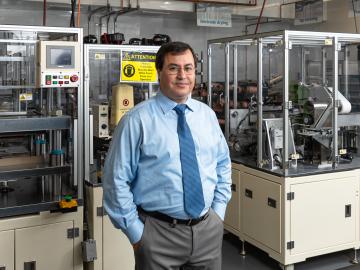
Filter News
Area of Research
- (-) Computer Science (8)
- (-) Energy Science (107)
- (-) Fusion Energy (1)
- Advanced Manufacturing (1)
- Biology and Environment (31)
- Computational Biology (1)
- Computational Engineering (2)
- Electricity and Smart Grid (3)
- Energy Sciences (1)
- Functional Materials for Energy (2)
- Fusion and Fission (5)
- Isotopes (1)
- Materials (40)
- Materials for Computing (5)
- National Security (21)
- Neutron Science (14)
- Nuclear Science and Technology (3)
- Quantum information Science (1)
- Sensors and Controls (1)
- Supercomputing (63)
News Topics
- (-) Energy Storage (72)
- (-) Grid (40)
- (-) Machine Learning (11)
- (-) Mercury (3)
- (-) Summit (6)
- 3-D Printing/Advanced Manufacturing (80)
- Advanced Reactors (13)
- Artificial Intelligence (14)
- Big Data (9)
- Bioenergy (26)
- Biology (11)
- Biomedical (6)
- Biotechnology (4)
- Buildings (38)
- Chemical Sciences (14)
- Clean Water (8)
- Composites (17)
- Computer Science (39)
- Coronavirus (12)
- Critical Materials (9)
- Cybersecurity (9)
- Environment (54)
- Exascale Computing (3)
- Fossil Energy (2)
- Frontier (3)
- Fusion (16)
- High-Performance Computing (8)
- Hydropower (3)
- Isotopes (1)
- Materials (36)
- Materials Science (29)
- Mathematics (2)
- Microelectronics (1)
- Microscopy (8)
- Molten Salt (1)
- Nanotechnology (8)
- National Security (5)
- Neutron Science (11)
- Nuclear Energy (17)
- Partnerships (12)
- Physics (1)
- Polymers (11)
- Quantum Science (5)
- Security (6)
- Simulation (4)
- Space Exploration (3)
- Statistics (1)
- Transportation (66)
Media Contacts

Scientists at ORNL used neutron scattering and supercomputing to better understand how an organic solvent and water work together to break down plant biomass, creating a pathway to significantly improve the production of renewable

Researchers at Oak Ridge National Laboratory developed a method that uses machine learning to predict seasonal fire risk in Africa, where half of the world’s wildfire-related carbon emissions originate.

Oak Ridge National Laboratory scientists seeking the source of charge loss in lithium-ion batteries demonstrated that coupling a thin-film cathode with a solid electrolyte is a rapid way to determine the root cause.

Ada Sedova’s journey to Oak Ridge National Laboratory has taken her on the path from pre-med studies in college to an accelerated graduate career in mathematics and biophysics and now to the intersection of computational science and biology

Oak Ridge National Laboratory researchers have developed a thin film, highly conductive solid-state electrolyte made of a polymer and ceramic-based composite for lithium metal batteries.

Researchers at the Department of Energy’s Oak Ridge National Laboratory are refining their design of a 3D-printed nuclear reactor core, scaling up the additive manufacturing process necessary to build it, and developing methods

Researchers at Oak Ridge National Laboratory demonstrated a 20-kilowatt bi-directional wireless charging system on a UPS plug-in hybrid electric delivery truck, advancing the technology to a larger class of vehicles and enabling a new energy storage method for fleet owners and their facilities.

Suman Debnath, a researcher at ORNL, has been elevated to the grade of senior member of the Institute of Electrical and Electronics Engineers (IEEE).

Researchers at the Department of Energy’s Oak Ridge National Laboratory (ORNL) in late February demonstrated a 20-kilowatt bi-directional wireless charging system installed on a UPS medium-duty, plug-in hybrid electric delivery truck.

Ilias Belharouak is leading ORNL’s research efforts in investigating new materials for solid-state batteries, which can double the charging capacity of lithium-ion batteries, commonly used today for electronic devices such as cell phones.


